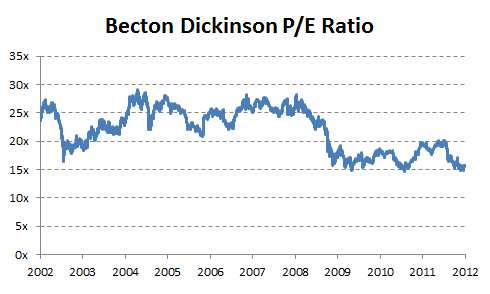A Brief History of Becton, Dickinson's Returns
Despite constant attempts by analysts and the media to complicate the basics of investing, there are only three ways a stock can create value for shareholders:
Dividends.
Earnings growth.
Changes in valuation multiples.
In this series, we drill down on one company's returns to see how each of those three has played a role over the past decade. Step on up, Becton Dickinson (NYS: BDX) .
Becton shares returned 168% over the past decade. How'd they get there?
Dividends pulled part of the weight. Without dividends, shares returned 130% over the past 10 years.
Earnings growth was substantial. Becton's normalized earnings per share grew 13.4% a year. That's well above the market average, and ample given the weak state of the economy, punctuated by two recessions over the last decade.
But hold on. If earnings grew over 13% a year, why did shares rise only 130% in a decade? Another way to look at it: earnings increased more than threefold, while shares a little more than doubled. This chart explains why:

Source: S&P Capital IQ.
Becton shares were fairly overvalued a decade ago. Ten years of generally declining multiples have prevented part of the company's earnings growth from materializing into shareholder returns. Put simply, the market isn't willing to pay as much for $1 of Becton's earnings as it was in the past.
The good news is that, at around 15 times earnings, Becton shares look like a fairly good value today. While the past decade has seen valuations contract, the coming decade could see stable, even expanding, valuations, helping more of the company's earnings growth turn into shareholder returns.
Why is this stuff worth paying attention to? It's important to know not only how much a stock has returned, but where those returns came from. Sometimes earnings grow, but the market isn't willing to pay as much for those earnings. Sometimes earnings fall, but the market bids shares higher anyway. Sometimes both earnings and earnings multiples stay flat, but a company generates returns through dividends. Sometimes everything works together, and returns surge. Sometimes nothing works and they crash. All tell a different story about the state of a company. Not knowing why something happened can be just as dangerous as not knowing that something happened at all.
Add Becton, Dickinson to My Watchlist.
At the time thisarticle was published Fool contributorMorgan Houseldoesn't own shares in any of the companies mentioned in this article. Follow him on Twitter, where he goes by@TMFHousel.Motley Fool newsletter serviceshave recommended buying shares of Becton. Try any of our Foolish newsletter services free for 30 days. We Fools don't all hold the same opinions, but we all believe that considering a diverse range of insights makes us better investors. The Motley Fool has a disclosure policy.
Copyright © 1995 - 2012 The Motley Fool, LLC. All rights reserved. The Motley Fool has a disclosure policy.

